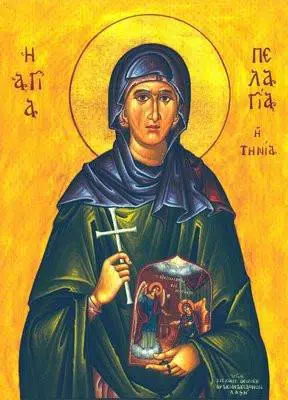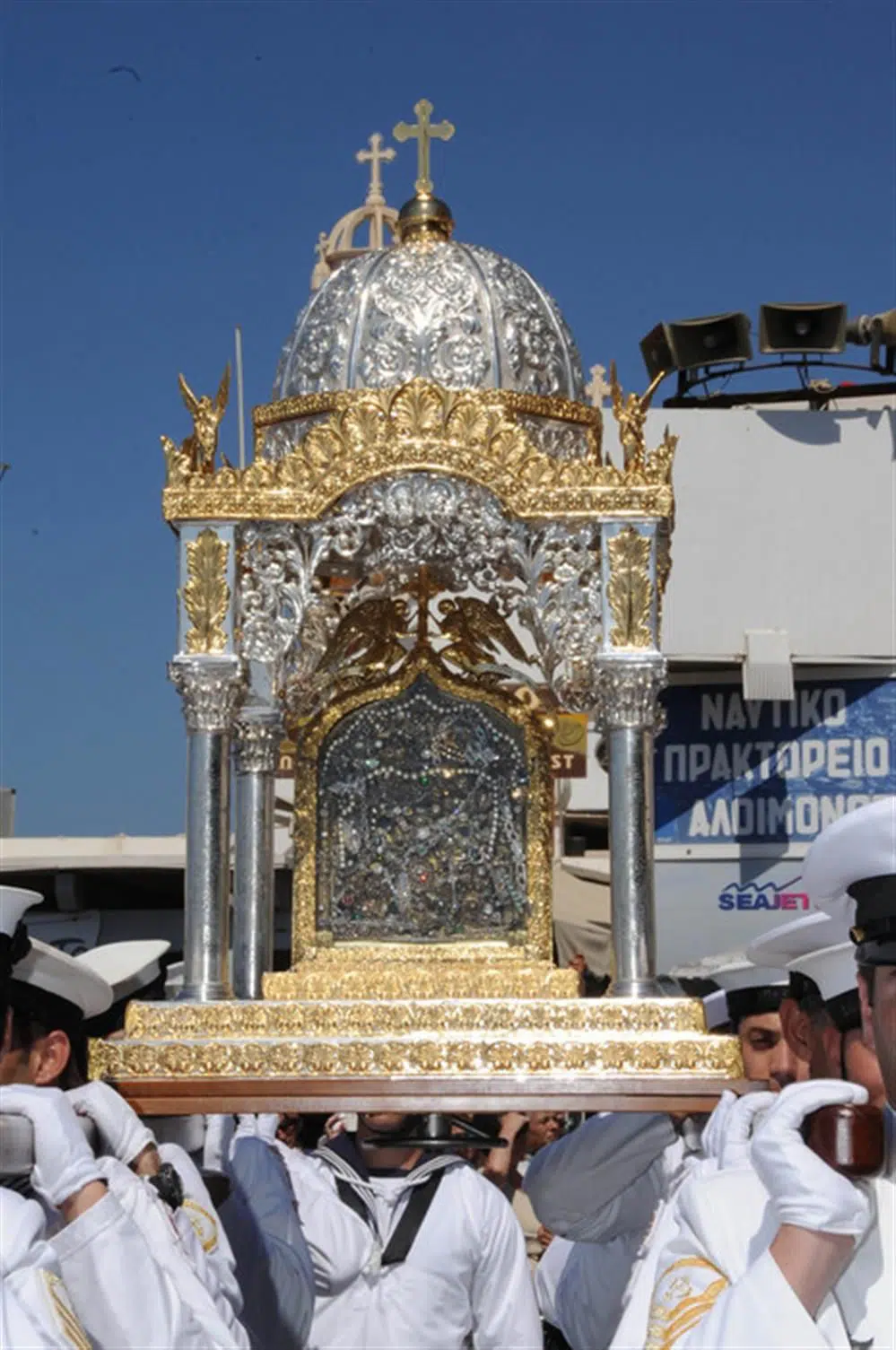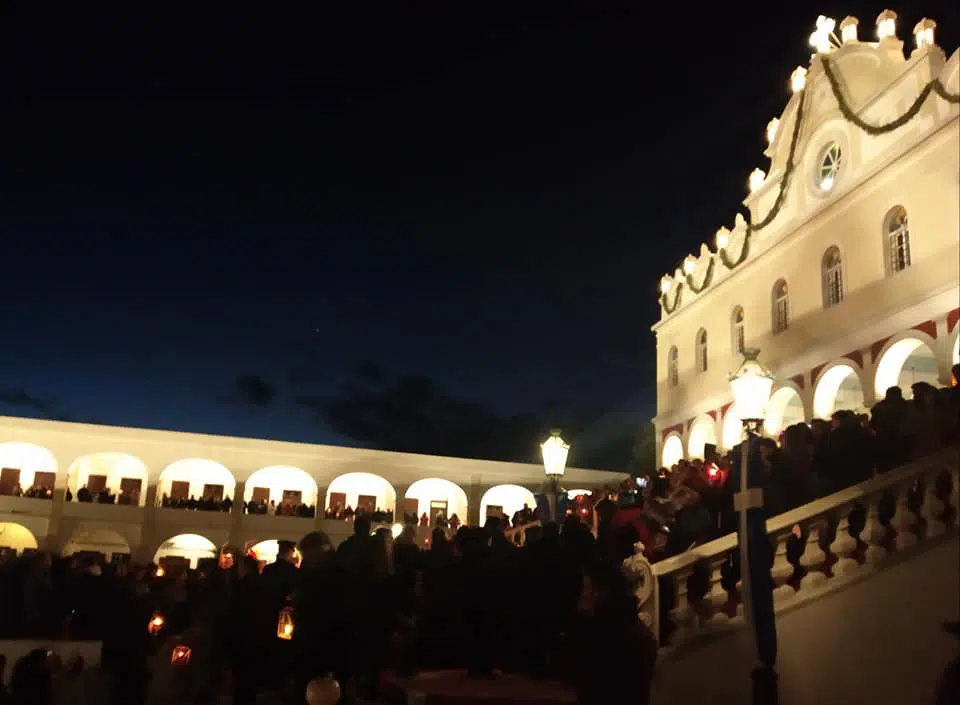
The Virgin Mary takes center stage in Tinos on August 15 annually, thanks to a humble nun who received a vision, whom we know as Agia Pelagia, or St. Pelagia, today, on the great feast of the Panagia, or the Dormition of the Virgin Mary.
Millions have made the pilgrimage to Tinos to venerate the miraculous icon of the Virgin Mary, in the magnificent temple Evangelistria Tis Theotokou. Following contact with the icon as well as prayers and promises dedicated to the Virgin Mary, many who were severely ill recovered and have been healed.
Pilgrimages are made by the faithful, praying for their own miracles as they disembark the ship that brings them to the Cycladic island. Many crawl the length of the road on their knees in humility as they approach the church that houses the sacred icon.
The healing power of the icon has been documented for some 200 years. But the story behind the discovery of the icon is even more miraculous. It was as a result of the vision of a devout sister, living in the convent on Mount Kechrovounios in 1822 that the long-lost icon was able to be unearthed.

Agia Pelagia, or Saint Pelagia, is renowned in Tinos but her association with the miraculous icon of the Virgin Mary is not well-known across Greece and the world. The icon was lost for several centuries until a vision came to the humble nun.
The nun devoted herself to the worship of God and to the relief of sufferers. Because of the purity of her soul, the gentleness of her life, her self-denial and her desire for redemption, Pelagia became the vessel of the revelation from the Virgin Mary.
Pelagia, who lived in the convent from a young age, was known for her great virtue and piety. In the midst of the Greek Revolution, on Sunday, July 9, 1822, Pelagia, who was in her 70s, had a vision in her sleep.
A majestic lady bearing a halo explained how she had suffered, buried so many years under the ground. She ordered Pelagia to go to Stamatelos Kangades, a prominent man of the village, and tell him to uncover the church of St. John the Baptist in a field owned by Anthony Doxaras.
Terrified by the vision, Pelagia attributed the dream to her imagination. She began to pray. She was afraid to tell anyone about her dream. The following week, the Great Lady appeared to her again, reminding her of her instructions. Still, the nun remained silent and told no one of her vision. The Virgin Mary appeared a third time to her — but this time with a severe warning.
The Virgin Mary chastised the nun for her disbelief, saying, “Go and do as I told you. Be obedient.” Pelagia woke trembling with fear. She opened her eyes to see the same mysterious Great Lady she had seen while asleep. With a great effort she asked, “Who are you, Lady? Why are you angry with me, and why do you order me to do these things?”
The Great Lady raised her hand and said, “Proclaim, O earth, glad tidings of great joy.” Pelagia, understanding at last, joyfully exclaimed, “Praise, O heavens, the glory of God.”
She informed her Mother Superior of her visions and Kangades as well as Bishop Gabriel of these events. The bishop had already heard of the dream of Michael Polyzoes, and realized that the account of the nun Pelagia was similar to the vision Polyzoes had had.
The foundations of the church of St. John, destroyed by Arabs in 1200, were then uncovered in the field. An old well was also found near the church — but not the holy icon of the Virgin Mary, as Pelagia had been told.
The money then ran out, and so the effort was abandoned. Once again the Mother of God appeared to Pelagia, urging that the excavations continue. Bishop Gabriel sent out an appeal for donations to build a new church on the foundations of the old church of St John the Baptist.
On January 30, 1823, workers were leveling the ground inside the church in preparation for laying down a new stone floor. About noon one of the workers, Emmanuel Matsos, struck a piece of wood with his pickaxe, splitting it down the middle. He looked at one piece of the board and saw that it was burned on one side, while the other side showed traces of paint.
As he brushed off the dirt with his hand, he saw that it was an icon. Joining the two pieces of wood together, he crossed himself and venerated the icon. He called the other workers, who also came and venerated the icon. When the icon was cleaned, the image was the Annunciation. The split was in the middle of the icon, between the Virgin Mary and the Archangel Gabriel.
Neither figure was damaged; this was regarded as a miracle.
That same day, the icon was given to Bishop Gabriel, who kissed it and cried out, “Great art Thou, O Lord, and wondrous are Thy works.” After the finding of the icon, the inhabitants of Tinos were filled with zeal to build a magnificent church in honor of the Theotokos. People offered their money and their own labor to help build the church of the Evangelistria, which translates as “She who Received the Good News.”
The new church, which was completed in 1823, was consecrated by Bishop Gabriel. Pelagia died on April 28, 1834. Her own Feast Day, however, is on July 23. The Tinos Icon of the Annunciation continues to be venerated as one of Greece’s holiest treasures. Innumerable miracles of healing and deliverance from danger have not ceased since the time the icon was found.

Icon’s Discovery Taken as Sign of Hope for Revolution
News of the icon’s discovery spread throughout the Hellenistic world. People arrived from every corner of Greece to venerate the Icon and beg for the liberation of the nation. Greeks now felt certain of their liberation.
The event was taken as a clear divine message of the primacy of Greek-Orthodox Christianity, favoring the justice of the revolution. Important figures of the Revolution arrived on the island to pay homage to the icon, among them Theodoros Kolokotronis, Miaoulis, Nikitaras and Makrygiannis.
Construction of the Church of Evangelistria
The discovery of the icon was followed by the building of the Church. It required great quantities of marble, which were mainly transported from the neighboring island of Delos, once the home of the ancient Greek gods, according to mythology.
It also required a great number of workers, skilled in the processing and installation of marble — but mostly a lot of money; the lack of funds often left the project’s overseers in an awkward position as they faced difficulties both in paying workers at the end of each week and paying for materials.
But again, as if by a miracle, all problems were resolved with generous contributions both of time and money by the people of Tinos, as well as from the entire Christian population of Greece and abroad.
By mid-1832 the east wing of the complex had been erected, together with the section to the east of the bell tower and the section east of the central entrance. All construction work was completed in 1880.
Panagia Tinos Organization and Administration
The shrine of the pilgrimage operates under the name “Pan-Hellenic Holy Foundation of the Evangelistria in Tinos,” a legal entity under public law. This comprises the definition of the pilgrimage’s legal form, organization, management and activities, beyond its Ecclesiastical function. It is a charitable foundation with assets originating mainly from the donations made by the congregation of the Church. It is a gift not only to the anonymous congregation, but to the Greek nation in general.
The Holy Foundation of Evangelistria was formally established in January of 1825 with the drawing up of the “Testament of the Ktitores.” The “Ktitores” were the first Commissioners of the Church. They were the ones who had succeeded in discovering the icon and building the Church, along with largest part of the complex that surrounds the Church of the Evangelistria.
They drafted the Testament of the Holy Foundation of Evaggelistria, laying down the first rules for its administration, which have as their main goals education and charity.
Tinos Celebrates Icon Four Times Annually
Although August 15 seems to be the pinnacle of the annual celebration, Tinos has four different celebrations focusing on the miraculous icon. Two are dedicated the Annunciation, or Evangelismos, as it is known in Greek, on March 25 and the Dormition of the Virgin Mary, on August 15.
The other two Tinos celebrations are dedicated to Saint Pelagia herself as the one who received the visions. July 23 celebrates her first revelation, and a winter celebration on January 30, known as the “Fanerosi,” which means revelation or illumination in Greek, and locally known as the Fanerakia. Almost two centuries later, grand celebrations dedicated to the miraculous icon continue.

July 23 Celebration of Agia Pelagia in Tinos
On the morning of July 23, after the end of the service of celebration, held in the Church of the Annunciation, priests and the faithful accompany the icon to the square of Eleftherias to commence a procession of cars which transfer the Icon to the convent of Kechrovouni.
After the service at the church of Saint Pelagia, the convent residents treat their guests with coffee, doughnuts, Tinian raki, traditional sweets and lunch. Following Vespers they return to Tinos Chora, which is eight kilometers away, on foot. The holy icon is carried in the hands of the monks, who lead locals and visitors in chanting. As they pass local chapels the procession is heralded with church bells.
The procession eventually arrives at Agia Paraskevi, at the entrance to Tinos Chora, where a large crowd of people welcome and greet the icon. The procession continues towards the harbor and the festival culminates on the marble platform at the quay with chanted prayers from the clergy and fireworks over the water. The Tinos Philharmonic Band then accompanies the sacred procession back home to the Church of Annunciation.
August 15 is the Virgin Mary’s Mega Celebration Across Greece
On August 15 the Greek Orthodox Church commemorates the Dormition of the Theotokos, or Virgin Mary, a traditional, family-oriented feast of great significance. It is the greatest celebration established by the Greek Orthodox Church in honor of the Mother of Christ, also known as a Marian feast.
The Dormition, which is celebrated with great splendor, is also called the Easter of Summer. Many Aegean islands, and particularly Tinos, decorate an epitaph, or casket, in honor of Mary. In many towns and villages across the country, churches dedicated to the Virgin Mary organize traditional festivals.

Celebration of Pelagia’s Fanerosi on January 30
The celebration of the Fanerakia is very sweet and folksy, in that it involves the island’s children in the lantern-lit promenade in the evening. There is a morning liturgy, a promenade of the holy icon through the city streets in the afternoon, a Vespers service at sunset and the parade of the lanterns — The Fanerakia — at twilight.
The hymns are celebratory and the lanterns are light wooden creations supported on a long cane so they can be held high into the sky.
See all the latest news from Greece and the world at Greekreporter.com. Contact our newsroom to report an update or send your story, photos and videos. Follow GR on Google News and subscribe here to our daily email!



